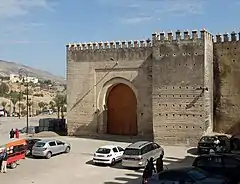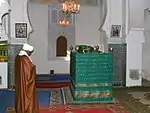Bab Mahrouk
Bab Mahrouk (also spelled Bab Mahruq) is historically the main western city gate of Fes el Bali, the old walled city of Fes, Morocco. The gate dates from 1204 and is located on the northwestern corner of Place Bou Jeloud, near the edge of Kasbah an-Nouar. It was historically the approximate starting point of the old city's main street, Tala'a Kebira.[1]:126
| Bab Mahrouk | |
|---|---|
باب المحروق | |
 | |

| |
| General information | |
| Type | city gate |
| Architectural style | Almohad, Moorish, Moroccan |
| Location | Fez, Morocco |
| Coordinates | 34°03′45″N 4°59′9.8″W |
| Completed | circa 1212 |
History
The current gate was built in 1204 by the Almohad ruler Muhammad al-Nasir (ruled 1199-1213), who rebuilt the city walls and fortifications of Fes generally.[2][3] It was also known (perhaps at an earlier period before the Almohad construction) as Bab ash-Shari'a (meaning roughly "Gate of Justice/Law"), but became known as Bab Mahruq ("Gate of the Burnt") after the body of a Wazzani rebel called al-'Ubaydi was burnt here in 1203-04 (600 AH).[1]:110 The heads of executed rebels were hung here on display, a practice that continued on occasion even up to the beginning of the 20th century.[1][3] On some occasions the condemned were hung by the wrists just above the ground for a full day before their execution.[1] Today the gate is still standing but several other openings in the wall have been created nearby to allow for the passage of vehicles and regular traffic.
Description
Like many medieval fortified gates, the gate has a bent entrance, entered from the west but turning 90 degrees to the south.[4] It opens through a large horseshoe or Moorish arch, surrounded by a shallow rectangular frame (similar to Bab Mahrouk on the other side of the city).[2] Another simple opening in the walls, inserted in recent times for better circulation, can also be found to the south of the gate structure.
West of the gate, outside the city walls, stretches the historic Bab Mahrouk Cemetery, one of the main cemeteries of the old city. It includes the mausoleum of 12th-century Islamic scholar Abu Bakr ibn al-Arabi.[1]:106
 Bab Mahrouk Cemetery
Bab Mahrouk Cemetery Mausoleum of Abu Bakr Ibn al-Arabi
Mausoleum of Abu Bakr Ibn al-Arabi Interior of the mausoleum of Ibn al-Arabi
Interior of the mausoleum of Ibn al-Arabi
References
- Le Tourneau, Roger (1949). Fès avant le protectorat: étude économique et sociale d'une ville de l'occident musulman. Casablanca: Société Marocaine de Librairie et d'Édition.
- Métalsi, Mohamed (2003). Fès: La ville essentielle. Paris: ACR Édition Internationale. ISBN 978-2867701528.
- Parker, Richard (1981). A practical guide to Islamic Monuments in Morocco. Charlottesville, VA: The Baraka Press. p. 127.
- Touri, Abdelaziz; Benaboud, Mhammad; Boujibar El-Khatib, Naïma; Lakhdar, Kamal; Mezzine, Mohamed (2010). Le Maroc andalou : à la découverte d'un art de vivre (2 ed.). Ministère des Affaires Culturelles du Royaume du Maroc & Museum With No Frontiers. ISBN 978-3902782311.